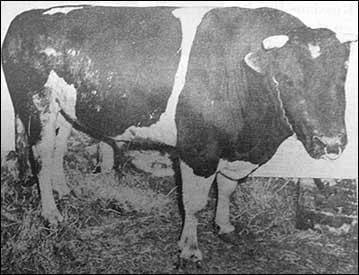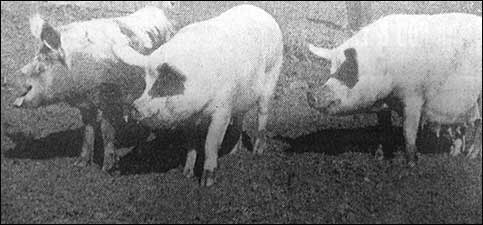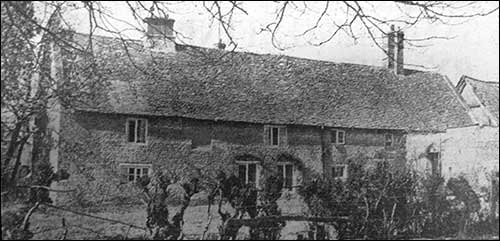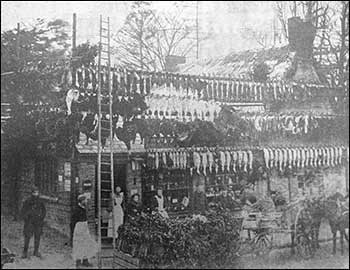|
|
||||||
| The Rushden Echo and Argus, 30th April 1954, transcribed by Gill Hollis |
||||||
|
The Willmott Saga – it started with one cow
|
||||||
|
||||||
| This is the tale of tall-hatted Farmer George Willmott, his children and his grandchildren, ten of whom are associated with farming in the Rushden district today. It is a family saga covering 100 years. The characters are sixteen Willmotts and a milking cow. The Willmotts of today work nine farms, totalling 2,200 acres or more. They naturally think rather proudly of George No. 1, who began it all in the middle of the last century. He was a cobbler, living in the southern part of the village. One day he bought a cow and began selling milk at his house. It proved a good idea, as George, who always believed in turning his money over, acquired the Blousic farmhouse on Fitzwilliam Hill – then an isolated position. He secured land, too – lots of it, sweeping north-westward from Blousic to The Moors between Washbrook Road to Hayway. But then, as Rushden changed suddenly into a town, much of the farm land was wanted for streets. George, however, made good his territorial losses by renting Knuston Farm (about 300 acres) from the Arkwrights, of Knuston Hall. Blousic was the milking headquarters. George had also established a picturesque butchers and greengrocery shop at the corner of High Street and College Street – the site of the present Midland Bank. Milk was on sale there, and the display of turkeys at Christmas was one of the sights of Rushden. Up In Flames This thatched shop went up in flames during Cave’s great factory fire of 1901. But George Willmott promptly built four new shops on the other side of High Street, keeping one for himself. This is still a Willmott shop to-day. Of the founder’s family, three sons, Alfred, John and George the Younger, became farmers. Elizabeth – now Mrs. Lack, the only survivor, who lives at The Cottage, Chelveston – managed the shop. Ellen, who did not marry, looked after the milk sales at Blousic Dairy. The younger George went to Knuston, Alfred to Chelveston, and John to Manor Farm in Bedford Road, Rushden. Meanwhile the father, now ranking as a gentleman farmer, had become a prominent local character, panoplied in tall black hat and riding in his pony trap. He died in 1913, after a long life of hard work and fearless enterprise. The saga now moves to the third generation. This is how they are deployed: Children of Alfred: William and Arthur, owners of Turnell’s Farm (where William lives) between Rushden and Wellingborough. Southfields (Arthur’s home), near Stone Cross, Irthlingborough, and Redgate Farm, Ditchford Lane; Mrs. Mayes at Blousic. Sons of John: Leonard, Harry, George, Hugh and Roland, jointly owning Manor Farm, Rushden, Hilly Farm, Rushden, and Stanwick Hall Farm and renting Rectory Farm, Rushden. Hugh runs the shop in Rushden High Street. Sons of George: George, now the owner of Knuston Farm, and Herbert, who has Stanwick Home Farm. The first group farms about 700 acres, the second 1,000, and the third between 500 and 600. Danish Style Dairying is still a leading line with the Willmotts, and practically all the milk is retailed in Rushden. There are T.T. attested herds on all the farms, totalling about 150 head. Store cattle number 400-500, tegs 200, fat pigs 500 a year.
Other stock includes three herds of pedigree Friesians and three of Shorthorns. General farming is worked to a four-year cropping plan, the crops including wheat, barley, oats, peas, kale and fodder beet. The farms, highly mechanised, are getting well into the press button stage. Horses Are Out There is not a horse in the whole group, though the acreage held is greater than at any other time in the history of the Willmott enterprise. Of all the farmhouses, Manor Farm, in Bedford Road, Rushden is the special treasure. Scheduled as a building of historic value, it was built in 1606 and bears the crest of the Prince of Wales on an ancient tablet, indicating that Royalty once stayed there. Eight of its windows were closed up at the time of the Window Tax, and others have old inscriptions. ………………
The Rushden Echo and Argus, 14th May 1954 What a Mouth Watering Sight
But this picture was taken long, long ago. Only those who have known Rushden for more than half a century and whose memories are good, will recognise this little corner shop decked out for Christmas. Today it is the site of one of the town’s most impressive buildings – the former Post Office, now occupied by the Midland Bank – where High Street and College Street meet. But even when this photograph was taken 70 years ago, the greengrocery and dairy produce shop was equally important in its way. It was half thatched-half slated, and adjoined the stone garden wall of a cottage which was overhung with trees at one of the narrowest parts of a still rural-looking High Street. The shop was founded by Mr. George Willmott, whose story as the head of a prosperous farming business was told in this paper two weeks ago. The shop served Rushden until 1901 when embers from the great fire at John Caves and Sons’ boot factory set the thatch alight and the building was destroyed. |
||||||
|
||||||
|
|
||||||
|
|



